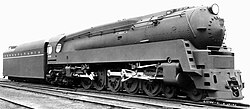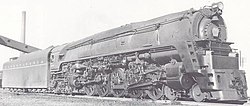Pennsylvania Railroad class Q1
This article includes a list of references, related reading, or external links, but its sources remain unclear because it lacks inline citations. (November 2014) |
| PRR Q1 | |||||||||||||||||||||||||||||
|---|---|---|---|---|---|---|---|---|---|---|---|---|---|---|---|---|---|---|---|---|---|---|---|---|---|---|---|---|---|
 | |||||||||||||||||||||||||||||
| |||||||||||||||||||||||||||||
| |||||||||||||||||||||||||||||
| |||||||||||||||||||||||||||||
| |||||||||||||||||||||||||||||

The Pennsylvania Railroad's class Q1 comprised a single experimental steam locomotive for freight service, #6130, built in March 1942. A duplex locomotive, it had a wheel arrangement of 4-6-4-4, comprising a four-wheel leading truck, two sets of driving wheels (six followed by four) in a rigid locomotive frame, and a four-wheel trailing truck. The first group of six driving wheels was driven by a pair of cylinders mounted conventionally in front of them, while the rear four driving wheels were driven by cylinders mounted behind them on either side of the firebox.
Unusual for a locomotive designed for pure freight service, it was given passenger-locomotive sized driving wheels at 77 in (1.956 m) and streamlining in the form of a bluntly pointed nosecone on the smokebox front as well as long side skirts covering up the locomotive's pipework. The cab front was set at a rakish angle. The tender, although given a freight locomotive's "doghouse" on the rear deck for the head-end brakeman, was otherwise a streamlined affair very similar to that used on the S1, S2, and T1 passenger locomotives.
During its short service life it spent more time in shops or the enginehouse than being run, accumulating only about 65,000 service miles in its career. It was assigned to the St. Clair Avenue Enginehouse in Columbus, Ohio and ran mostly in the Ohio area and to Chicago, Illinois.
In December 1944 it appeared at a PRR exhibition in Chicago's Union Station entitled "Presenting a Line of Modern Coal-Burning Steam Locomotives". At some time during the next year it lost much of its streamlining, the nosecone being removed in favor of a conventional PRR smokebox front including the keystone numberplate placed centrally on the small smokebox door. A headlamp bracket mounted above that door also hung the locomotive's bell. The side skirting was cut back to expose pipework and fittings for easier maintenance. The skyline casing atop the boiler remained in place.

The Q1 remained in service until late 1946, after which it was placed in storage. It was dismantled around 1949.
The PRR considered the Q1 design unfit for series production, and railroad historians consider it largely a failure. The backwards-driving rear cylinders were a poor choice; mounted next to the firebox, each constrained the other's size, and the area by the firebox was dusty and hot, which increased cylinder wear. These problems had previously been encountered on the B&O's N-1 duplex. The length of steam pipes required also meant a fair degree of power loss. Added to this, the passenger-locomotive sized drivers were a poor choice for a freight locomotive.
From its experiences with this locomotive, the PRR came up with an improved design, the Q2. This had normal-sized drivers, cylinders mounted in front of the wheels they drove, and were built largely unstreamlined.
References
- Staufer, Alvin (1962). Pennsy Power. Staufer. pp. 216–225. LOC 62-20872.
- Brian Reed (June 1972). Loco Profile 24: Pennsylvania Duplexii. Profile Publications.
- Harley, E.T. (1982). Classic Power 5: Pennsy Q Class. Hicksville, New York: N.J. International. ISBN 0-934088-09-8.
- Duplex locomotives
- Pennsylvania Railroad locomotives
- 4-6-4-4 locomotives
- Streamlined steam locomotives
- Experimental locomotives
- Individual locomotives of the United States
- Steam locomotives of the United States
- Scrapped locomotives
- Unique locomotives
- Freight locomotives
- Standard gauge locomotives of the United States
